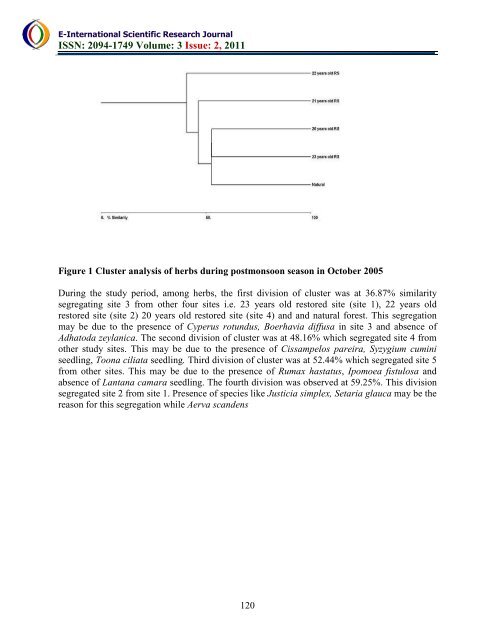download the full article here - E-International Scientific Research ...
download the full article here - E-International Scientific Research ...
download the full article here - E-International Scientific Research ...
Create successful ePaper yourself
Turn your PDF publications into a flip-book with our unique Google optimized e-Paper software.
E-<strong>International</strong> <strong>Scientific</strong> <strong>Research</strong> Journal<br />
ISSN: 2094-1749 Volume: 3 Issue: 2, 2011<br />
Figure 1 Cluster analysis of herbs during postmonsoon season in October 2005<br />
During <strong>the</strong> study period, among herbs, <strong>the</strong> first division of cluster was at 36.87% similarity<br />
segregating site 3 from o<strong>the</strong>r four sites i.e. 23 years old restored site (site 1), 22 years old<br />
restored site (site 2) 20 years old restored site (site 4) and and natural forest. This segregation<br />
may be due to <strong>the</strong> presence of Cyperus rotundus, Boerhavia diffusa in site 3 and absence of<br />
Adhatoda zeylanica. The second division of cluster was at 48.16% which segregated site 4 from<br />
o<strong>the</strong>r study sites. This may be due to <strong>the</strong> presence of Cissampelos pareira, Syzygium cumini<br />
seedling, Toona ciliata seedling. Third division of cluster was at 52.44% which segregated site 5<br />
from o<strong>the</strong>r sites. This may be due to <strong>the</strong> presence of Rumax hastatus, Ipomoea fistulosa and<br />
absence of Lantana camara seedling. The fourth division was observed at 59.25%. This division<br />
segregated site 2 from site 1. Presence of species like Justicia simplex, Setaria glauca may be <strong>the</strong><br />
reason for this segregation while Aerva scandens<br />
120

















